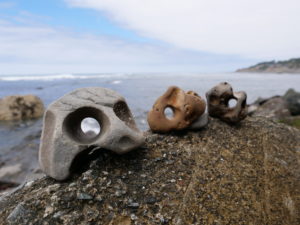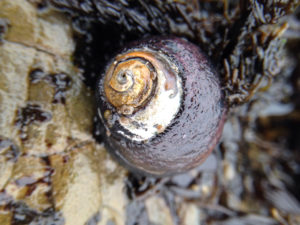Q: What native land snails live in the Bay Area? Where do the common garden snails come from, and what’s the status of our native snail populations? [Erica, Mountain View]
A: If you are a gardener like me, you eventually come to despise snails with a passion, even if you’re a kind, gentle, loving person. And while you would not dream of actually torturing them, you have few qualms about ending their slimy little mollusk lives.
Our wet and relatively mild Bay Area winters are peak time for land mollusks. The snail that most of us encounter is the European garden snail (Helix aspersa). These animals were brought to California over 100 years ago, allegedly as a food resource. So when you collect them in your garden, you might as well eat them. They are about 15 percent protein, 3 percent fat, and the rest water. Dipping them in garlic butter will greatly improve the flavor and add quite a few calories. But make sure to properly prepare these snails, which must be purged before it’s safe to eat them (search “snail’s pace” at Matt Bites for details).
So much for nonnatives. I remember the first native snail I ever saw in the Bay Area. Hiking in Muir Woods in early winter, I found a lovely specimen. The shell was very dark and not as tall as the common garden snail. The flesh had beautiful, subtle shades of purple. It was Monadenia infumata, or the Monadenia land snail, and simply gorgeous.
The most common native land snails are the shoulderbands in the genus Helminthoglypta. They can be easily confused with garden snails. But instead of the broad, somewhat fuzzy brown pigment of the European snails, these natives have a very distinct single dark band that wraps around the shell at the “shoulder.” There are over 60 species in California, including the Morro shoulderband snail or banded dune snail (Helminthoglypta walkeriana) and the Coast Range shoulder-band snail (Helminthoglypta nickliniana), among others. Mostly our native snails can be found in relatively undisturbed native ecosystems.
Another snail that is commonly overlooked is called Haplotrema minimum, the California lancetooth. This species not only feeds on plant material but also hunts and eats other snails and slugs.
Dr. Barry Roth compiled the “Checklist of the Land Snails and Slugs of California,” available from the Santa Barbara Museum of Natural History, and he is generally considered our local snail and slug expert. He says there is no indication that the introduced European garden snails and other exotic land mollusks are affecting our native snail populations. The introduced species live in areas with significant habitat modification, where the natives are already long gone. Apparently as long as the habitat is intact, the native snails will do fine.




